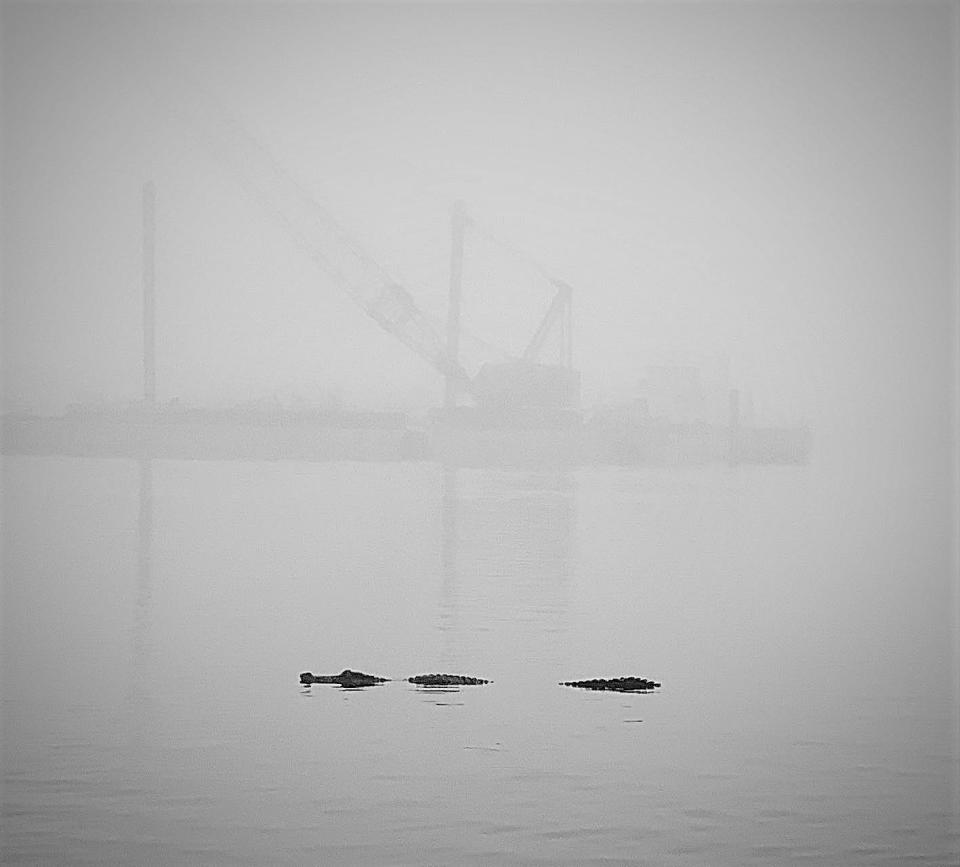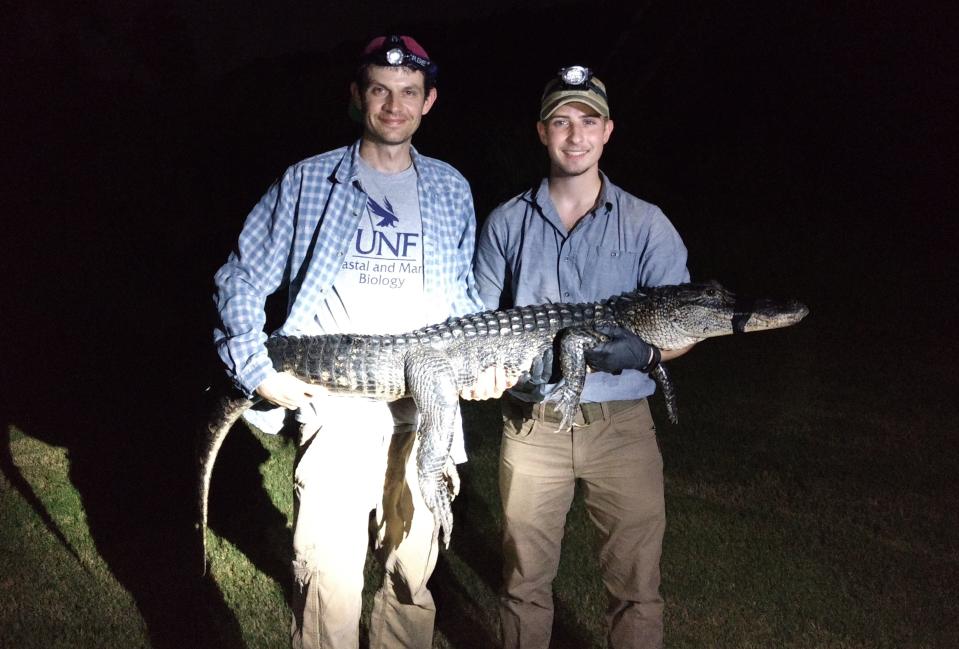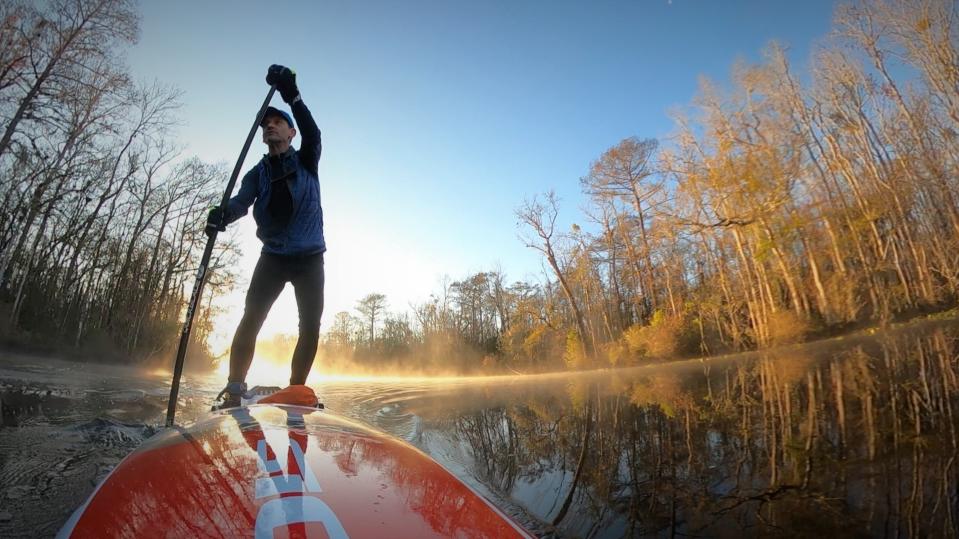In Florida, what's more dangerous than paddling with gators? That's a long list | Mark Woods
Alligators have been in the headlines this summer.
When an elderly Florida woman fell into a pond near a Gulf Coast golf course and was killed by two alligators, it was the second fatal alligator attack in the state this year. And it came after another fatal attack in South Carolina.
This prompted stories everywhere from New York tabloids to golf magazines and cable news networks.
Combine this with the video that went viral last year — of a woman paddleboarding in Silver Springs, using her paddle to push a gator away from her board — and it led to people asking me the question I’ve been hearing ever since I started paddleboarding more than a decade ago.
“Aren’t you afraid of the gators?”
More from Mark Woods: A strange feeling about Jacksonville's riverfront — optimism
From sports: Jaguars want stadium with shade? Look at what Dolphins did in Miami — without tax dollars
No, not those Gators: Gene Frenette: Florida-Georgia tradition should take priority over Kirby Smart's recruiting obsession
My usual response starts with denial. What gators? There aren’t any gators where we paddle. I mean, we hardly ever see any. So I can assume there aren’t any in the dark, murky water underneath my board, right?
This is partly true. We’ve spent hundreds of hours, maybe even thousands, in our local waterways and I can count on my fingers how many gators we’ve seen. We’ve had much closer encounters with manatees. My friend Mat Rini didn’t see a manatee in front of him and accidentally glided onto its back – and with a flick of the manatee’s powerful tail, Mat was launched from his kayak like a pilot being ejected from a plane.
We’ve had dolphins swim right alongside our boards.
But gators? What gators?

I know that the truth is they are there. Probably everywhere. Even right in the middle of downtown Jacksonville. We did see one there once, in the St. Johns River near the Shipyards. It was a foggy December morning. I was paddling with Dan Gamsky and saw what I thought was a log that resembled a big gator.
“I could take a picture of that log and tell people it’s a gator,” I said.
As we got closer, Dan said: “I think it is a gator.”
We took a wide path around it. The gator didn’t move. Even when a fish jumped right next to it. In fact, it was so still that we started to think it was a fake gator, maybe someone’s idea of a prank. Then it started to move very slowly, heading the opposite direction we were, adding to my sense of a mutual understanding with gators.
Neither of us wants to get too close to the other.
Me: “I could take a picture of that log and tell people it’s a gator.”
Dan: “I think it IS a gator.”
It was. And we didn’t get any closer than this. No need to end up as a @FloridaMan__ tweet. pic.twitter.com/G8825cw0cb— Mark Woods (@TUmarkwoods) December 30, 2018
A gator in that spot probably is a rarity. But I know that they’re there in some of our go-to spots — like paddling from the Hood Landing boat ramp into Durbin and Julington creeks.
It’s Florida, home of more than 1 million alligators.
I figure there are two ways to think about this statistic. One is to be terrified by it. The other is to be comforted by it. I try to convince myself the latter makes sense.
Even with so many gators in the state, alligator attacks are extremely rare — about six incidents of alligator bites a year, and about one fatality every three years.
It reminds me of when a lifeguard at the beach told me about flying along Florida’s coastline, looking down and seeing hundreds of sharks not far offshore. The first impulse is to hear the Jaws soundtrack. The second is that it affirms what we hear scientists and surfers say repeatedly: If sharks truly were looking to bite humans, it would happen much more often than it does.
It seems like we write a lot about sharks and dolphins and manatees. But for some reason, alligators are more like the actual animals, out of sight and out of headlines, until there’s an attack.
'More likely to get killed by a dog than a gator'
So I decided to contact a few people who know gators, starting with Dr. Adam Rosenblatt, an assistant professor of biology at the University of North Florida.
Rosenblatt’s doctorate involved alligator behavior in the Everglades. He spent six years studying how alligators respond to natural changes in salinity, during tidal and seasonal cycles, in the water they inhabit. This allowed him and his colleagues to get a sense of what could happen as sea level rise continues to increase the salinity of our waterways.
The results in a nutshell: Alligators are very sensitive to salinity. And when the water gets too salty, most of them will abandon coastal areas and move inland.
At UNF, he has continued to lead crocodilian research, doing alligator surveys in St. Johns tributaries: Clapboard Creek, Dunn Creek, Trout River, Broward River, Arlington River, Julington Creek and all the way down to Black Creek.
Again, water salinity is part of the equation. The less salinity, the more gators.
“We found the biggest numbers in Black Creek,” he said.

This doesn’t mean there aren’t gators near our coast. In fact, he says the biggest local numbers — and largest gators — likely are in a body of water that isn’t a tributary: Guana Lake.
Not that any of these statistics, or the ones that have made headlines recently, should prompt panic. He said that having some human-alligator interactions at this time of year in the Southeast isn’t anything new — but there has been a “slow trend” toward more incidents.
He points to two primary reasons for this. There are more people living here. And as climate change extends our hottest time of the year, it also extends the period when gators are most active. Put those together and you have a few more incidents.
Still, he says, we should keep the risk in perspective.
“When you look at the number of alligators that are in this state, and the number of people that are in this state, the amount of conflict that happens between us and alligators is very, very low,” he said. “You're more likely to be hit by lightning than to get killed by an alligator. You're more likely to get killed by a dog than get killed by an alligator.”
Having said that, he adds that alligator encounters shouldn't be taken lightly. Sometimes it starts with the gator going after a pet and an owner trying to protect it. Often it’s the result of gators being fed by humans and expecting more food. The latter likely was what preceded the incident with the paddleboarder in Silver Springs last year.
After that video went viral — the gator was killed by state officials — the 60-year-old paddleboarder was harassed online.
Rosenblatt echoed what I thought at the time: The people who deserved to be criticized were the ones who fed the alligator. The paddleboarder had good reason to be nervous — and to push the gator away with her paddle.
“I would’ve been even more aggressive,” he said. “I would’ve taken my paddle and smacked it pretty hard in the jaw.”
Have we lost ability to accurately judge risk in nature?
I also contacted Ben and Louann Williams. They used to own Fisherman’s Dock Seafood Market in Mandarin. After selling the business, they moved to several thousands of acres of land in Putnam County. In 2019, they were recognized by the Florida Fish and Wildlife Conservation Commission as the Florida Land Steward Landowner of the Year.
They’ve also been featured in the paper for pulling record-setting alligators — including several over 13-feet long — out of Lake George.
They know gators. And while they’ve hunted gators with state-issued permits, they don’t want to rid the state of gators. To the contrary, they stress the importance of having gators in Florida. That’s one of the things they brought up when asked about the recent headlines.
“It does seem only the ‘danger’ pieces make the news, which paints a very unrealistic picture of any potential for negative interactions,” Ben Williams said. “Which, in a sad sort of way, maybe at times keeps people from enjoying our waters … or from even appreciating the gators themselves as being important to the environment.”
He said they’ve seen the same thing happen with people avoiding hiking in the woods because of bears.
“As we've become much more the urban species ourselves we've lost the ability to judge risk in the natural world,” he said. “Maybe because we are unfamiliar with it, we think snakes and ticks and bears and gators make going into the woods or on our waters more dangerous than driving out to dinner or to a concert — which of course we both know the driving is far more likely to do us in.”
He’s right. Is there some risk to paddling in Florida waters?

Of course. The risk is not nothing. But there might be a bigger risk in driving to the boat ramp. Or riding a bike on our roads. Or trying to walk somewhere. Or any number of things we do every day without thinking twice about it.
Or at least that's what I tell myself when people ask about paddling with the gators.
mwoods@jacksonville.com
(904) 359-4212
This article originally appeared on Florida Times-Union: Alligator attacks are rare in Florida, even if you're paddleboarding

